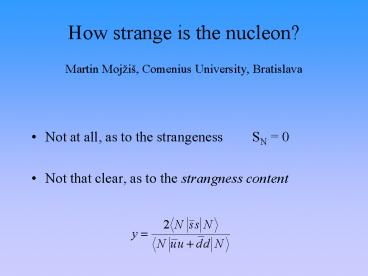How strange is the nucleon? Martin Moj - PowerPoint PPT Presentation
1 / 20
Title:
How strange is the nucleon? Martin Moj
Description:
Not at all, as to the strangeness SN = 0. Not that clear, as to the strangness content ... redoing the KH analysis for the new data is quite a nontrivial task ... – PowerPoint PPT presentation
Number of Views:35
Avg rating:3.0/5.0
Title: How strange is the nucleon? Martin Moj
1
How strange is the nucleon?Martin Mojžiš,
Comenius University, Bratislava
- Not at all, as to the strangeness SN 0
- Not that clear, as to the strangness content
2
the story of 3 sigmas
(none of them being the standard deviation)
baryon octet masses
?N scattering (CD point)
?N scattering (data)
3
the story of 3 sigmas
Gell-Mann, Okubo Gasser, Leutwyler
baryon octet masses
26 MeV
64 MeV
simple LET
64 MeV
Brown, Pardee, Peccei
?N scattering (CD point)
64 MeV
Höhler et al.
?N scattering (data)
data
4
big y
26 MeV
64 MeV
OOPS !
5
big y
is strange
26 ? 0.3
64 MeV
376 MeV
64 MeV
500 MeV
6
big why
Why does QCD build up the lightest baryon using
so much of such a heavy building block?
s ?d
does not work for s with a buddy d with the same
quantum numbers
but why should every s have a buddy d with the
same quantum numbers?
7
big y
? small y
?
- How reliable is the value of y ?
- What approximations were used to get the values
of the three sigmas ? - Is there a way to calculate corrections to the
approximate values ? - What are the corrections ?
- Are they large enough to decrease y
substantially ? - Are they going in the right directions ?
8
the original numbers
SU(3)
group theory
current algebra
SU(2)L ? SU(2)R
current algebra
SU(2)L ? SU(2)R
dispersion relations
analycity unitarity
?N scattering (data)
9
the original numbers
- controls the mass splitting (PT, 1st order)
- is controlled by the transformation properties
- of the sandwiched operator
- of the sandwiching vector
(GMO)
10
the original numbers
the tool effective lagrangians (ChPT)
chiral symmetry
11
the original numbers
- one from ?, others with c2,c3,c4,c5
- all with specific p-dependence
- they do vanish at the CD point ( t 2M?2 )
other contributions to the vertex
for t 2M?2 (and ? 0) both ?(t) and
(part of) the ?N-scattering
are controlled by the same term in the Leff
12
the original numbers
underestimated error
extrapolation from the physical region to
unphysical CD point
KH analysis
- a choice of a parametrization of the amplitude
- a choice of constraints imposed on the amplitude
- a choice of experimental points taken into
account - a choice of a penalty function to be minimized
- see original papers
- fixed-t dispersion relations
- old database (80-ties)
- see original papers
- many possible choices, at different level of
sophistication - if one is lucky, the result is not very
sensitive to a particular choice - one is not
- early determinations Cheng-Dashen ? 110 MeV,
Höhler ? 42?23 MeV
- the reason one is fishing out an intrinsically
small quantity (vanishing for mumd0) - the consequence great care is needed to extract
? from data
13
corrections
SU(3)
group theory
ChPT
current algebra
SU(2)L ? SU(2)R
ChPT
current algebra
SU(2)L ? SU(2)R
ChPT
dispersion relations
analycity unitarity
?N scattering (data)
14
corrections
Feynman-Hellmann theorem
Borasoy Meißner
- 2nd order Bb,q (2 LECs) GMO reproduced
- 3rd order Cb,q (0 LECs) 26 MeV ? 33?5 MeV
- 4th order Db,q (lot of LECs) estimated
(resonance saturation)
15
corrections
3rd order Gasser, Sainio, Svarc
4th order Becher, Leutwyler
estimated from a dispersive analysis (Gasser,
Leutwyler, Locher, Sainio)
16
corrections
3rd order Bernard, Kaiser, Meißner
4th order Becher, Leutwyler
large contributions in both ?(M?2) and
? canceling each other
estimated
17
corrections
Gasser, Leutwyler, Sainio
- a choice of a parametrization of the amplitude
- a choice of constraints imposed on the amplitude
- a choice of experimental points taken into
account - a choice of a penalty function to be minimized
- see original papers
- forward dispersion relations
- old database (80-ties)
- see original papers
forward disp. relations data ? ? 0, t 0
linear approximation ? 0, t 0 ? ? 0, t
M?2 less restrictive constrains better
control over error propagation
18
corrections
33?5 MeV (26 MeV)
44?7 MeV (64 MeV)
59?7 MeV (64 MeV)
?N scattering (CD point)
60?7 MeV (64 MeV )
?N scattering (data)
data
19
new partial wave analysis
VPI
- a choice of a parametrization of the amplitude
- a choice of constraints imposed on the amplitude
- a choice of experimental points taken into
account - a choice of a penalty function to be minimized
- see original papers
- much less restrictive -
- up-to-date database
- see original papers
20
no conclusions
Roy-like equations
- a choice of a parametrization of the amplitude
- a choice of constraints imposed on the amplitude
- a choice of experimental points taken into
account - a choice of a penalty function to be minimized
- Becher-Leutwyler
- well under controll
- up-to-date database
- not decided yet
- new analysis of the data is clearly called for
- redoing the KH analysis for the new data is
quite a nontrivial task - work in progress (Sainio, Pirjola)
- Roy equations used recently successfully for
??-scattering - Roy-like equations proposed also for
?N-scattering
- work in progress































